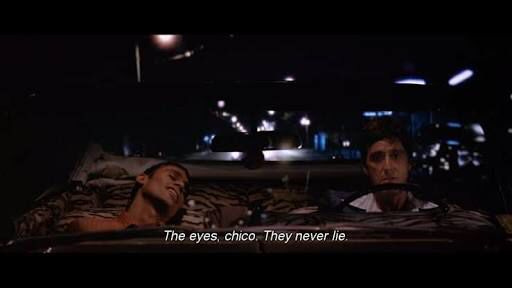Deep Dive: Gen Z and the female vs male gaze
You may have heard Gen Zers on TikTok talking about the female or male gaze. We're here to explain what that's all about. 👁️👄👁️
👋 Hi! We’re The Z Link, a global Gen Z-led social media agency that helps brands reach our generation. The Digital Native, written by our Trends Reporter, Shaurya, takes a deep dive into niche internet micro-trends and subcultures, and analyzes them so you don’t have to. For any feedback, questions or suggestions, just reply to this email! <3
“The eyes, chico. They never lie.”
Okay yeah, I just wanted to quote Scarface; it doesn't actually have anything to do with what we're talking about today, except it absolutely does because we're talking about the male and female gaze. If you've been on the internet for the last two years, you've probably heard the terms “male gaze” and “female gaze” (and seen some film students die on the inside because of it), especially on TikTok. What is it, though, and why has TikTok gotten it so wrong? Let's unpack. 💡
The male gaze is theorised by Laura Mulvey, who states that women in media are primarily depicted through the eyes of a heterosexual and masculine perspective, resulting in them being objectified and sexualised. The male gaze often focuses only on a part or some parts of a woman, whereas the female gaze portrays the world and everything in it through a woman's eyes. The female gaze doesn't aim to sexualise (although it could take that direction at times) the characters it's seeing. It focuses on intimacy, rawness, emotions and vulnerability. If the male gaze objectifies, the female gaze subjectifies. Fragment vs whole. Harley Quinn is the best example of the male gaze vs the female gaze in a singular character. Harley Quinn in Suicide Squad (2016) is a prime example of the male gaze, whereas Harley Quinn in Birds of Prey (2020) is the female gaze.
We see the male gaze take effect in media in many different forms — fashion choices, camera angles, and the relationship between characters. This might not sit well with some film students, but hear me out. The male gaze portrayal in media is translated into real life whether we like it or not. Like yes, it's just a theory, but is it any longer a theory if the masses in real life feel the effects of it? Life imitates art and art imitates life.
If that wasn't bad enough, TikTok swoops in and makes it worse. All love, but the app has gotten it so wrong, especially in recent times with the female gaze. TikTok's approach to the male vs female gaze theory gave way to multiple trends, the most prominent one being women mocking female characters in media written by men who really started the entire conversation, or at the very least boosted it and brought it to the spotlight.
This article explains the whole thing in depth ⬆️
The trend entailed women pretending to be characters in media written by a man doing mundane tasks but in a hyper-sexualised way. The trend really went on to show how wrong men can get it sometimes because we don't want to dance around while getting our morning coffees, we're barely functioning at that point, and the only thing on my mind after I wake up is how I want mother earth to consume my flesh and bone with Hozier playing in the background… and then I eat, and all is right in the world.
MOVING ON, the most recent trend that has taken TikTok by storm is the female gaze trend, which is still being interpreted wrong (are we surprised?). The trend was started by a user named Kevin. Kevin was lip-syncing to Justin Bieber's Boyfriend, and the entire premise of the video was to show how confidence can change a lot (check out the link, you’ll understand the vibe straight away). The videos usually start with the user acting awkward and eventually relaxing their eyes for a more confident look.
Now, this is all well and good, BUT IT’S NOT THE FEMALE GAZE. Sorry, I get very passionate about this. 👀 Right, staring at the camera a certain way ≠ the female gaze. Even if this was the female gaze, many of the videos under the trend have missed the point. Confidence vs cocky, “I'm lucky to have you” vs “you're lucky to even be in my presence”, look of adoration vs look of lust. It's the same thing with doe eyes vs siren eyes. They weren't siren eyes. It was just the Kubrick stare. All of these TikTok trends have taken these theories and reduced them to something very superficial, erasing the point entirely.
Right, so what have we learnt today? Say it after me: the female gaze is a perspective, not the way someone stares at the camera.
But no, seriously, let's all collectively take a vow to understand what the male and female gaze is because, like I said, the effects of these are genuine, and I personally think it's time we see a lot more genuine female gaze in the mainstream media.
💭 What are the best or worst examples of this that you’ve seen in the media? Let us know, let’s discuss!
Any questions/suggestions as to what we should cover next? Reach out to us and we’re always here to chat!
— Written by Shaurya, Trends Reporter at The Z Link







